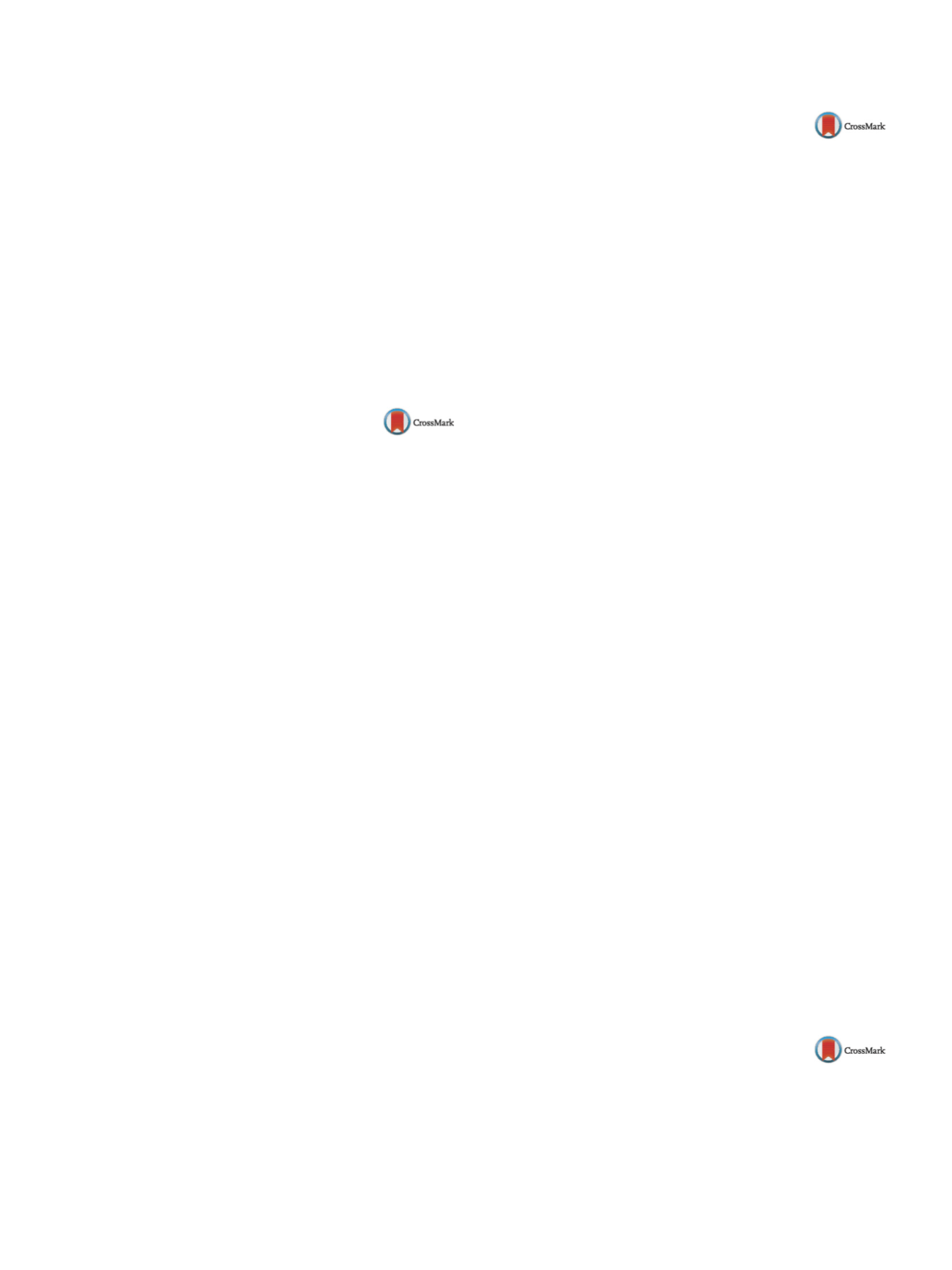

S446
25th European Congress of Psychiatry / European Psychiatry 41S (2017) S405–S464
memory for objects in immediate and delayed conditions. Two-
way ANOVA was used to reveal group differences in reproducing
the objects in two conditions.
We have not revealed significant differences between children from
experimental and control group in the reproducing the objects in
immediate condition. However, the interaction of condition type
and group was significant (
P
≤
0.05). ADHD children were less
successful in reproducing the objects in delayed condition.
In view of the obtained results, it can be assumed that children
with ADHD have specific deficit in memory domain – weakness in
delayed memory.
Disclosure of interest
The author has not supplied his declaration
of competing interest.
Acknowledgements
The research was supported by Act 211 Gov-
ernment of the Russian Federation, agreement No. 02.A03.21.0006,
by Russian Foundation for Basic Research, grant No. 15-06-06491A.
http://dx.doi.org/10.1016/j.eurpsy.2017.01.460EV0132
Child obsessive-compulsive disorder
presenting with catatonic-like
features: Case presentation
V. Kodra (Resident in Child, Adolescent Psychiatry)
1 ,∗
, V. Alikaj
2,
B. Allkoja
2, B. Zenelaj (Resident in Child, Adolescent Psychiatry)
1,
D. Sanxhaku (Resident in Child, Adolescent Psychiatry)
31
Psychiatry, Durres, Albania
2
Psychiatry, Child and Adolescent, Tirana, Albania
3
Psychiatry, Tirana, Albania
∗
Corresponding author.
Introduction
Although catatoniawas conceptualized as a subtype
of schizophrenia, it is now recognized to occur most commonly in
the course of other psychiatric disorders, in drug-induced disorders
[1] or neurologic conditions
[2] . Catatonia is rarely seen together
with OCD and there are a limited number of case reports in the
literature
[3,4] .Objective
We describe the case of a 12 year boy who presented in
our clinic with mutism, negativism, immobility, social withdrawn,
rigid posture, refusal to eat.
Method
We performed a thorough psychiatric diagnostic assess-
ment of the child as well as laboratory tests and MRI of the brain.
Results
The child’s first symptoms appeared 2 years ago: ini-
tially the child became socially withdrawn, spent most of time at
his room, and became preoccupied with rituals of hand washing,
walking back and forth, preoccupations with food contamination,
became aggressive if someone would interrupt what he was doing,
stopped going at school, and stopped calling his parents “mother”
or “father”. Brain MRI showed lateral ventricular asymmetry and
suboccipital cyst.
Conclusions
The child was put on therapy with lorazepam and
sertraline. His obsessive-compulsive symptoms improved, and the
apparent catatonic like features resolved and did not return over
follow-up.
Discussion
Catatonia is not uncommon among children and ado-
lescents, and the relationship between OCD and catatonia is still
misunderstood, but it may be an indicator of the severity of the
OCD.
Disclosure of interest
The authors have not supplied their decla-
ration of competing interest.
Reference
[1] Duggal HS, Singh I. Drug-induced catatonia. Drugs Today (Barc)
2005;41:599–607.
[2] A clinician’s guide to diagnosis and treatment. Cambridge Uni-
versity Press; 2003.
[3] Catatonia in OCD: etiopathogenesis, differential diagnosis, and
clinical management. Cogn Behav Neurol;20(1):21–4.
[4] Catatonic signs in OCD. J Clin Psychiatry;50(8):303–5.
http://dx.doi.org/10.1016/j.eurpsy.2017.01.461EV0133
Clinical and psychopathological
aspect of electrophysiological
abnormalities in adolescents with
behavior disorders
I. Leshchyna
1 ,∗
, T. Mozgova
1, S. Fedorchenko
21
Kharkiv National Medical University, Psychiatry, Narcology and
Medical Psychology, Kharkiv, Ukraine
2
Kharkiv Medical Academy of Postgraduate Education,
Neuropathology and Neurosurgery, Kharkiv, Ukraine
∗
Corresponding author.
Medical and social significance of behavioral disorders in adoles-
cents and their consequences makes the relevance of the study of
clinical manifestations and causes the need for early preventive
intervention.
Aim
Studying the role of neurophysiological disorders in the for-
mation of behavior disorders in adolescents.
Two hundred and two adolescents aged 11–15 years with behavior
disorders were observed. The diagnostic methods included electro-
physiological, clinical psychopathological and statistical methods.
In the structure of behavioral disorders, psychopathological syn-
dromes in adolescents have been identified: psychopathic (
n
= 106),
asthenoneurotic (
n
= 50), asthenoabulic (
n
= 26) and anxiety-
depressive (
n
= 20).
As a result, it was found that high seizure activity com-
monly observed in adolescents with anxiety-depressive syndrome
(66.67
±
10.33%); less frequently in adolescents with asthenoneu-
rotic (40.00
±
6.79%), psychopathic (38.71
±
4.64%), asthenoabulic
(28.57
±
8.68%) syndromes.
At the same time, diffuse changes with dysregulation of the
diencephalic-stem structures were observed in the majority
of adolescents with psychopathic (61.29
±
4.64%), asthenoneu-
rotic (60.00
±
6.79%), asthenoabulic (57.15
±
9.51%) syndromes and
much less frequently in adolescentswith anxiety-depressive symp-
toms (33.33
±
10.33%).
Dystonic rheoencephalography type was observed in a third
of adolescents with psychopathic (35.48
±
4.55%), asthenoneu-
rotic (30.00
±
6.35%) and anxiety-depressive (33.33
±
10.33%)
syndromes, while the hypertensive rheoencephalography type
was prevailed in adolescents with astenoabulic symptoms
(14.29
±
6.73%).
Liquor hypertension in adolescents with asthenoneurotic
(15.00
±
4.95%) and psychopathic (9.67
±
2.81%) syndromes
was more common.
The statistical analysis indicated that violations of bioelectric prop-
erties of the brain with high seizure activity and dysfunction of
the low stem structures and disorders of cerebral hemodynamics
by dystonic type are risk factors for the formation of behavioral
disorders in adolescents.
Detection of neurophysiological disorders in adolescents is an
informative diagnostic method of early signs of behavioral disor-
ders.
Disclosure of interest
The authors have not supplied their decla-
ration of competing interest.
http://dx.doi.org/10.1016/j.eurpsy.2017.01.462EV0134
Guide for adults in the children’s
therapeutic tale: “I conquered my
fears”
C. Lima
1 ,∗
, G .Cunha
2 , M.Figueiredo (Conflict mediator)
3 ,F. Moreira
31
ForAll, Desenvolvimento Pessoal e Bem-Estar, Unipessoal, Lda.,
Psicologia, Porto, Portugal
2
Mediare, Porto, Portugal
3
ESENF, ESENF, Porto, Portugal


















